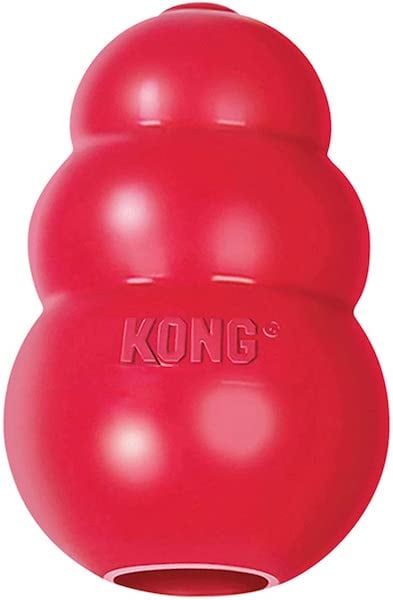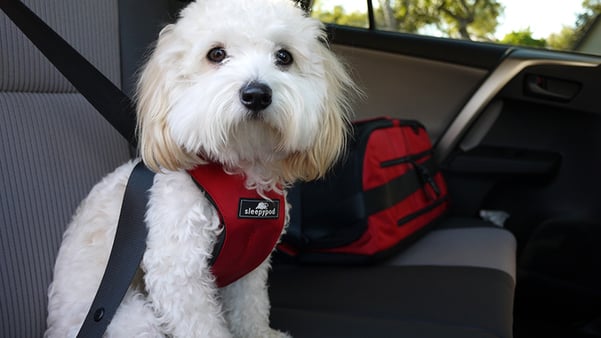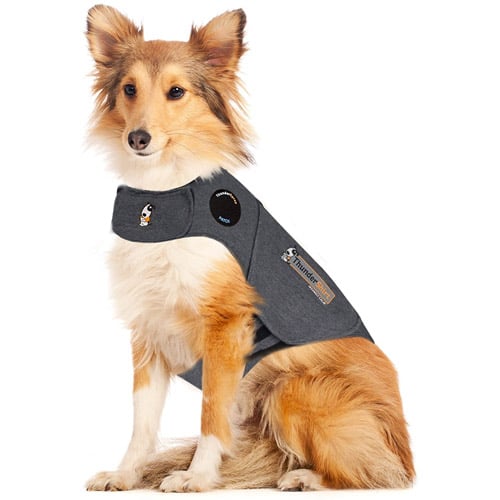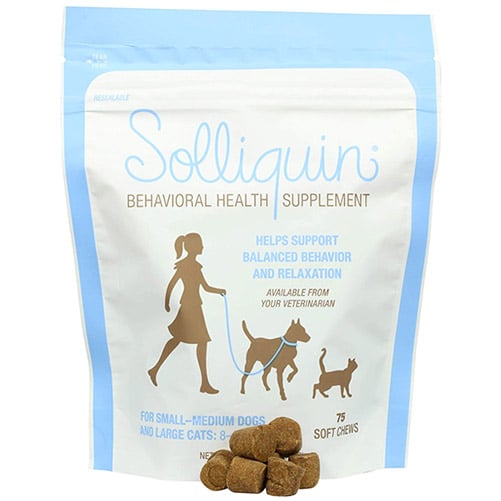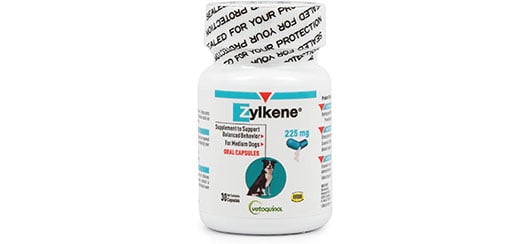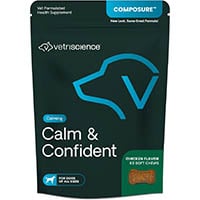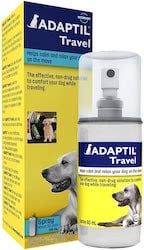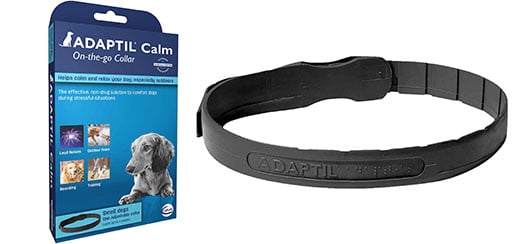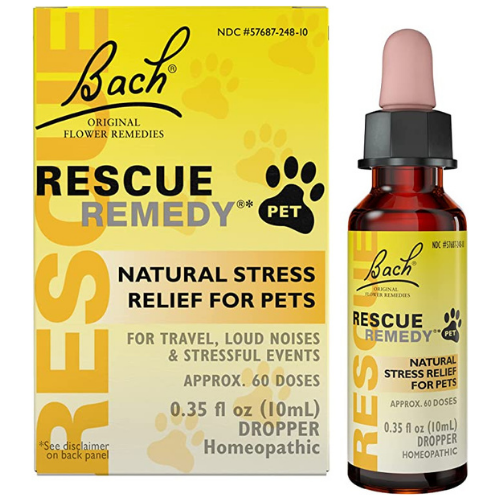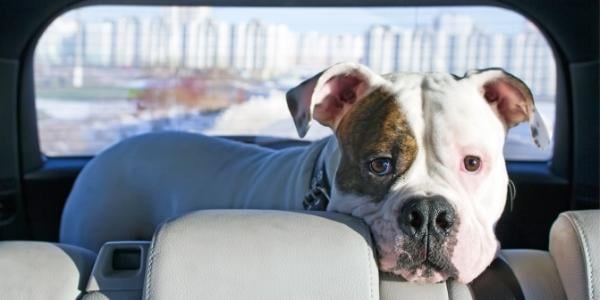
Does your dog get anxious in the car? Do they pant and never settle down? Travel anxiety can ruin a road trip before you even hit the highway.
What can you do about it?
Fortunately, quite a few things — give the suggestions in this article a whirl to make Fido a better traveler.
Dogs can be great travel companions, but before you gas up the car and back out of the driveway, there are definitely a few things you can do to make your dog's trip in the car smoother, safer, and more enjoyable for everybody.
Car Sickness in Dogs
Dogs can get car sick while riding in the car, and often this leads to travel anxiety. Puppies are more often affected by motion sickness, and many grow out of it around one year old.
Feeling sick whenever they are in the car doesn’t help build a positive association for your dog, which contributes to the anxiety they feel when they have to go for a car ride. To find out how to help your dog if they get car sick, check out our article “Preventing and Treating Car Sickness in Dogs.”
Help Your Dog Feel Comfortable in the Car
For many dogs, a trip to the vet is the main reason they get to ride in the car. Therefore, many dogs make the association that a car ride = a vet visit. This is called “classical conditioning” (Does Pavlov ring a bell, anyone?). And since many dogs don’t always love what happens at the vet, is it any wonder then that getting in the car can often trigger stress and anxiety for so many dogs?
Other dogs become anxious in the car because of previous bad experiences in the car, such as being left alone or a scary event such as a car accident.
Pro Tip: You can help your dog even more by following these additional tips to make vet visits less stressful.
The good news is that if you start young, you can prevent your dog from ever developing negative associations (and the resulting stressful state of mind) with the car using a process called desensitization. And if you already have a dog that exhibits anxiety during their car ride, it is possible to modify that association using counterconditioning.
The key to both desensitization and counterconditioning is recognizing that it’s not a race. Go slowly. Success is more likely with baby steps.
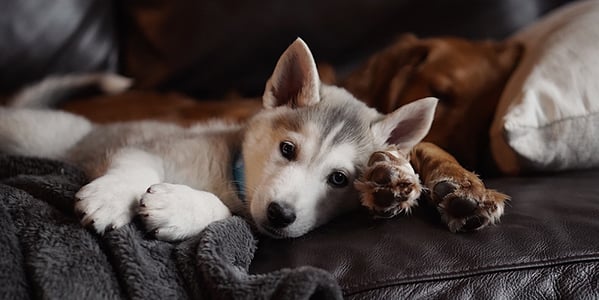
Desensitizing a Puppy to Enjoy Riding in the Car (Prevention)
- Start with the car parked and turned off. Sit next to your dog in the area you plan on having them regularly ride (we recommend the back seat or cargo area with proper travel safety restraints). Give your dog pets, praise, treats … whatever they love! Do this for just a few minutes at a time.
- After a few sessions in the same area as your dog, introduce being behind the wheel while your dog is still in their area. You can toss treats back to them and praise them whenever they are quiet and calm. This is a great opportunity for using a stuffed Kong or Toppl to build a positive association with staying calm and being further away from you while in the car.
After practicing with the car turned off, start to introduce turning the car on. Keep your own energy and attitude neutral while you turn the car on, wait a brief moment, and then turn it back off. The noise can be a little disconcerting at first, so toss a treat right after it happens.
- Start to increase the amount of time you leave the engine running, all the while making sure your pup is calm and happy with verbal praise and the occasional toss of a treat.
- If at any point you notice a fear response during this process, don’t panic! Your dog might back away, their ears might go back against their head, or they have a closed mouth and wide eyes.
- If you see them trying to avoid moving closer, trying to move further away from the car, or trying to jump out, that's a sign that they're stressed. Other subtle signals of stress include yawning, lip licking, or what are called "displacement behaviors."
- Displacement behaviors are otherwise normal behaviors being performed out of context when your dog is feeling emotionally conflicted, and include things like sniffing the ground, self-grooming, licking, sneezing, and scratching.
- Keep your energy positive to show your pup there’s nothing to worry about and offer some comfort. Then go back a step or lessen the intensity of the step you’re on.
- Start to add in more and more of the car ride process, making sure to reinforce calm behavior with praise and treats throughout. You can simply back out of the driveway before pulling back in or do a quick trip around the block before taking longer and longer trips. Go to lots of fun places with your puppy that they enjoy so they learn that car rides predict awesome things!
Counterconditioning Your Anxious Dog to Feel Better About the Car (Treatment)
You'll notice that the following counterconditioning steps are very similar to the desensitization steps outlined in the process above. The biggest difference is that your dog already has a negative association with being in the car versus a puppy who hasn't built any associations (good or bad) when you start introducing them to the car.
For this reason, you want to focus on rewarding your dog's choice to move towards the car in these steps.
Don't try to lure with a toy or treat or force them closer with leash pressure. Their confidence around the car will grow if they are given the choice to approach or get in the car, and that choice is rewarded with things they love.
The more a choice is rewarded, the more they will choose to make it. Patience is key!
Counterconditioning can take longer than desensitization, and you'll want to work in smaller steps and at a slower progression through the steps! You should also talk to your veterinarian or veterinary behaviorist early on to figure out which supplements or medications will help your dog remain as calm as possible.
Questions? To chat with a veterinarian about your dog's travel anxiety, Click here
A certified dog trainer can also help you manage this behavior modification process by showing you what stress signals to watch out for and helping you plan out your dog's program step-by-step. A trainer can provide support and encouragement while you build up the patience required for counterconditioning behavior modification.
Start Slow: Some dogs need to begin this process without even getting into the car. If your dog has extreme anxiety and starts to stress before they even get in the car, begin outside of the parked car. Any time they look at the car, offer them a treat and praise!
If they take a step towards the car, treat and praise. Or if they like to play, play some tug with them in the vicinity of the car. Do this for just a few minutes the first time, or even just a few seconds, depending on how stressed they are around the car. Do this daily, or every other day, for a few weeks.
Build Confidence: You can then have the car door open and repeat this process of giving high-value rewards for looking at and moving towards the car. You don't want to force them into the car — instead, you want them to choose to go towards the open door on their own and then reward them.
Reward Continued Progress: Once they've shown more confidence in approaching the open door, you can add in the step of jumping in (or being picked up and placed in the car, if they're small enough). Give lots of praise and a high-value treat when they put their feet in the car, and then let them jump out (or take them out) immediately if they'd like.
Practice this step until your dog is showing confidence in getting in the car and doesn't show signs of immediately wanting to get out.
Sit in The Car With Your Dog: Then, with the car parked, go into the back seat (or cargo area) with your dog. Pet them, praise them, and give them high-value treats (like little pieces of cheese, hot dogs, or whatever you know they really love).
Build Duration: Gradually increase the amount of time you're both spending in the car. Consider feeding them regular meals in the car, or sit with them calmly giving praise and pets.
Temperature-related emergencies are serious problems and can come on quickly — please see our important heatstroke information and resources.
What you’re trying to do here is change your dog’s previously bad association to a positive one. All of your dog’s favorite things now happen in the car — and positive experiences in the car abound. And for most dogs, food is incredibly positive!
But if your dog absolutely loves a certain toy or getting a nice, long massage from you, start to offer these things in the car as well.
Now that your dog is counterconditioned to simply being in the car start to take short trips around town to gradually get them more comfortable with traveling in the car.
Go to fun places – dog parks, play dates with your friend’s dogs, the pet store, or whatever else you think will be fun for your pet.
Do these regularly and gradually increase the distance you go. (Tip: you can keep going back to the same place, just take a different and progressively longer route.)
Please share your dog's anxiety experiences by taking this quick survey.
 The information you share will help many other dogs. It's anonymous and will take 2 minutes.
The information you share will help many other dogs. It's anonymous and will take 2 minutes.
Thank you!
Calm Your Dog
There are certain products and tricks you can use to try and calm your dog in the car. It’s difficult to predict which of these will work for a particular dog, so I recommend trying each of them until you find what works for yours.
Familiar Scents and Anti-Anxiety Jackets
Providing your dog with a favorite toy or an article of clothing with your scent (check your laundry basket) may help. This can calm your dog and make the car experience more enjoyable.
Just be careful and make sure your dog is not likely to chew up and eat what you offer. After all, if they eat it, you’ll likely be trading travel anxiety for an intestinal obstruction. Those obstructions can require costly surgery to resolve, so they’re best avoided.
You can also try putting clothes on your dog, such as the Thundershirt anxiety-reducing jacket for dogs. These jackets can help calm dogs in a variety of situations, including during car acclimation and travel.
Calming Supplements
There are some good calming supplements on the market that can help dogs relax a bit in a variety of situations. Which ones might work best for your dog in certain situations, like travel anxiety, can be a bit of trial and error. But the three listed below are often good, safe, and reliable places to start (after a conversation with your vet, of course).
Probiotics for Dogs
You may have heard of probiotics for dogs to help with overall gut health, but are likely wondering how they would help with travel anxiety. Well, recent research has established a link between a dog's gut microbiome and their nervous system, brain, and overall behavior. Select probiotics are formulated to enhance the gut microbiome, which, in turn, can lessen anxiety and modify behavior.
Probiotics help mitigate stress-induced symptoms such as vomiting.
One study conducted in humans revealed that intervention with probiotics resulted in a 10% reduction in seasickness. It's plausible that dogs may experience similar benefits from the use of probiotics to help with carsickness.
If you intend to use a probiotic supplement, I would recommend Purina's Calming Care. It may take up to a month to notice any benefits. If you have a big car trip coming up, begin adding this to your dog's food a month in advance.
Calming Pheromones
Pheromones are chemical "signals" produced by an animal's body that help them communicate with nearby animals of the same species. For several days after giving birth to a litter of puppies, a female dog releases a pheromone that helps calm and soothe her puppies, giving them a sense of security and comfort.
This pheromone has been copied synthetically and is available in both a spray and collar form. It’s called Adaptil™, sometimes sold under the Comfort Zone name. Spray a little (a spritz or two) of the travel spray on your dog's favorite stuffed toy or blanket prior to car travel, or put the Adaptil Comfort Zone Collar on your dog to help decrease their anxiety.
Homeopathic Remedies
Essences of flowers and plants make up homeopathic remedies that some people believe really help to calm their pet’s anxiety. One of the more popular products for dogs is Bach Rescue Remedy Pet — some people swear by it, which is why we're including it here.
If you want to try Rescue Remedy, you'll need to build it up in your dog's system for a day or two before and continue during travel. Give a dose every four hours in your dog's water, on their food or treats, or directly into their mouth.
The Car Environment
Some pets might travel better if there’s soothing music or fresh air in the car. Try playing classical music, soft rock, or reggae (read about what types of music are most calming for dogs here) or opening the windows a bit. Just don’t let your dog put their head out the window. Doing so risks injuries to their eyes, nose, and head.
Buckle Up Your Dog
Some dogs will feel less anxious if they are more physically secure in the car. Travel crates, carriers, and travel harnesses are all great ways to help your dog feel more secure and keep their footing during travel.
The best restraint for you will depend on the size of your dog, their comfort level with the restraint, and the type of car, truck, or SUV you drive. Find out our recommendations for the best dog travel harnesses, carriers, and crates in our "Buckle Up Your Pup" article.
An added bonus is that restraints are also important tools to keep both your dog and the other occupants of your car safe during travel. Learn about the dangers of unrestrained pets in this Pet Travel Safety Tip:
Medications For Your Dog's Travel Anxiety or Carsickness
Sometimes, no matter how much acclimation and calming you try, your dog may still need medication. Medication can relieve anxiety and help your dog enjoy car travel. In these instances, you’re going to have to consult with your veterinarian for specifics.
Only your veterinarian will best know and understand how certain medications, or combinations of medication and/or supplements, are likely to help and affect your dog.
Below are some of the types of medications that your veterinarian may prescribe to help your anxious dog travel better. These drug types are mentioned just to provide you with some information; these are not our veterinary team's specific recommendations or prescriptions.
Learn more about dog anxiety medications and supplements here.
A recent examination and doctor-patient relationship are vital to ensuring the safe and effective use of any medication. For specific recommendations and prescriptions, speak with your veterinarian or a board-certified veterinary behaviorist. Do not provide any of these medications to your dog without express instructions from your veterinarian.
Questions? To chat with a veterinarian about your dog's travel anxiety, Click here
Antihistamines: Medications in this drug class may lessen your dog’s travel anxiety and reduce their chances of carsickness through a variety of mechanisms, including their drowsiness-inducing effects and their direct action on your dog’s balance centers.
A common antihistamine used for pets is diphenhydramine (Benadryl®). Speak with your veterinarian about whether this might be an option for your dog, and use our Diphenhydramine Dosage Calculator to determine your dog's minimum and maximum dosage.
Anxiolytics: This class comprises a wide range of drugs that your veterinarian may prescribe for your anxious pet. As a drug class, they can reduce or block a dog’s anxiety, and some may also cause a degree of sedation.
Learn about the different anxiety medications for dogs available here.
Sedatives: Sedatives reduce your dog’s level of awareness, basically reducing agitation by decreasing your dog’s perception of the surroundings. There are medications that are specific sedatives, and others that have sedation as a side effect.
Only your veterinarian can decide if a sedative is right for your dog’s travel anxiety.
Neurokinin receptor blocker: Zoetis makes a unique drug that is highly effective at blocking the center within your dog’s brain responsible for the vomiting reflex. Translation: it is highly effective at preventing vomiting. However, it is only available by prescription and is not indicated for every dog or every situation. It’s called Cerenia®, and if these other measures have failed to control your dog’s car sickness, it’s certainly worthwhile to talk to your veterinarian about it.
If you have a dog that suffers from travel anxiety or carsickness, please fill out our survey. The information you share about your experiences will help many other dogs.
Happy travels!


